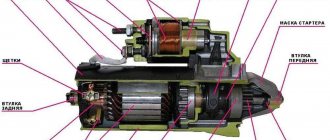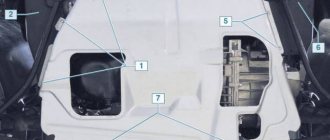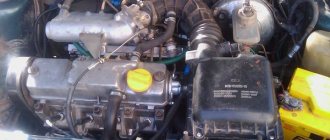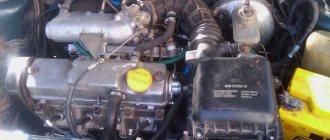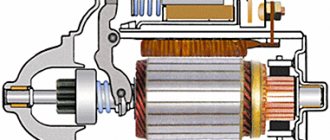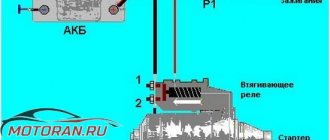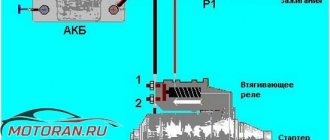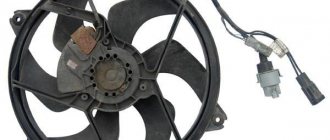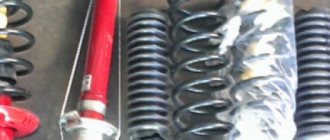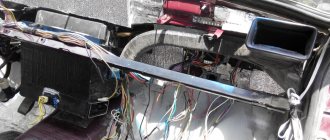If, when turning the key in the ignition switch, the starter simply clicks, but does not turn and, as a result, the engine cannot start, the reason here is quite simple and now we will deal with it in detail.
It's clear that when a car doesn't start right away, it annoys any motorist. The reasons are as follows: the contacts on the battery may simply become disconnected, and there may also be a malfunction in the starter. But an experienced driver, based on certain signs and clicks, will always be able to understand in which particular unit the malfunction occurred.
The starter and retractor relay clicks, what is the reason?
If the starter clicks on a VAZ 2114 and does not turn, then everything immediately becomes clear . These clicks come from the solenoid relay, but this does not mean that you need to change the starter solenoid relay. Current flows to it, which is why it clicks.
If these devices click, then this is not bad, because if there are clicks, then these devices are operational or partially operational.
In most cases, solenoid relays use an electromagnetic method to connect contacts.
When voltage is applied, the contact terminals receive charges with opposite poles, so they begin to attract and when they touch each other, they create a clicking sound.
In order for the engine to start, you need to make sure that these components are in good working order:
- the battery is charged with well-connected terminals;
- The ignition switch and its contacts must be in order;
- the starter relay, the solenoid relay and the starter itself.
Video tip: The starter clicks but does not turn:
Clicking sounds are heard, but the starter does not turn due to the windings or brush assembly
If the battery, ignition switch, contacts, wiring and starter relay are checked, but it still does not rotate when you turn the ignition key, then the problem is directly in the starter. In such a situation, you will have to completely remove it from the car, disassemble it and evaluate the possibility of repairs. You can also simply replace the starter with a new one.
If you decide to repair the starter yourself, know that the problem with it refusing to rotate under load may be due to:
- Faulty winding, which has a characteristic burnt color and smell;
- A faulty brush assembly, the wear of which is easily determined visually.
Starters are rarely repaired, and such a step should only be taken as a last resort. If it is possible to replace the starter, then it is better to do this than to bother with repairing the winding or brush assembly.
( 408 votes, average: 4.57 out of 5)
How to check the catalyst on a car yourself
The battery light on the instrument panel is on: causes, diagnosis, solution to the problem
Related Posts
The relay clicks, but the car does not start, what should I do?
As you understand, if there are clicks, then there is still hope that the car will be able to start. If the starter does not spin, you should definitely pay attention to the contacts of the traction relay. Therefore, the first thing you need to check is the following:
- battery, clean the terminals, perhaps there is simply no contact;
- check if the wires leading from the battery to the starter are in order;
- twitch the key in the ignition switch, perhaps there is a contact somewhere;
- the starter is broken, in this case you will have to remove it and reassemble it, but before that you need to make sure that there is no contact on the brushes;
- If the solenoid relay is broken, then you will just have to replace this unit.
Usually, the starter breaks down quite rarely, and so does the solenoid relay, so most likely it’s all about a discharged battery or missing contacts. If the battery has a weak charge, then it is clear that there will not be enough energy to turn the starter, but it may be enough to operate the charge relay, which is why these clicks are heard.
There are times when the starter takes over the current.
Troubleshooting wires
Some drivers, in search of a malfunction, are in a hurry to remove the starter, but such hasty actions should not be taken, since often the problem of the engine not starting is due to wires, poor contacts or their absence. Here are the most typical defects:
- low weight of the engine and body;
- unreliable connection of the starter wires (plus of the rotor winding, main plus, power supply contact from the ignition switch to the solenoid relay (SR)).
If there is a bad ground on the engine, a sign of a defect will be a slight click on the first attempt to start, then all the instruments may go out, and with the next turns of the key any signs of “life” will disappear altogether (but not necessarily). Checking the presence of mass is quite simple, but the check needs to be done by two people:
- one of the participants closes the mass terminal of the battery with the engine housing with a metal object (for example, a wrench or a cigarette wire);
- the second person, sitting behind the wheel of the car, turns the key all the way to the right;
- If there really was a bad ground, the starter will immediately start turning at normal speed.
You should also ensure the reliability of all fasteners on the starter; to do this, perform the following steps:
- unscrew all the nuts on the starter, having previously removed the terminals from the battery;
- wipe the joints and fasteners with a dry, clean rag;
- treat contacts with WD-40;
- tighten the nuts with the necessary force; do not overtighten, otherwise you may break the thread.
If the BP wire is connected using a connector, bend the tongue of the “chip”; here the connection should be tight.
When, after cleaning all contact parts, the engine starts, it means that the malfunction has been eliminated, and there is no need to find out what caused the defect. If nothing has changed for the better, then you should definitely check the starter; to do this, the unit will have to be dismantled.
How to check the starter
If everything is fine with the battery and the contacts too, then the problem is in the starter. and clicks for this reason . What should I do if the starter clicks but does not turn? To diagnose it and find out where exactly the clicks are coming from, you will have to remove the starter.
You may also be interested in: The best Italian cars: Ferrari, Lamborghini, Maserati and others
Then you need to put this starter on the table, take a charged battery and connect ground to the starter body, and connect the positive terminal to the pin that comes after the relay. If the starter turns, then everything is in order and there are no problems with the retractor relay either. And if the starter clicks, but does not turn as before, this means that there is a malfunction in it and you will have to disassemble it and look for the breakdown inside . The same must be done if the starter idles and does not engage.
How to eliminate the causes of problems starting the car engine
Buying a new starter is not always justified. The old unit can serve for a long time. It is enough to carry out qualified diagnostics and replace faulty internal parts: bushings, brushes.
If it is not possible to deliver a faulty car to a service station, then it is necessary to remove the faulty part and take it to a mechanic. Only qualified diagnostics using special equipment can identify the exact fault. Repairing internal parts is much cheaper than buying a new part.
Usually repairs do not take much time. It all depends on the workload of the repairman and the availability of the necessary spare parts. It is better to contact a service that specializes in repairing electrical equipment for cars. If circumstances are favorable, you will be able to get behind the wheel of your car the very next day.
The relay clicks, but the car does not start, how to start the car?
It seems like such a small unit, but it could be the reason why the car won’t start . But if you have a VAZ 2121 or any other VAZ with a manual transmission, then there is an excellent way out of the situation - just take and start the car from the pushrod. To do this, you need to turn the key, as you usually turn it when you want to start the car.
Then find several people and the whole crowd needs to push the car and continue to push it until the speed becomes more or less normal - about 5 km/h or more. At this moment you need to squeeze the clutch, engage 2nd gear and release the clutch, the car will jerk and should start, you need to give the gas at the moment when the car tries to start. If the car stalls, you need to repeat these steps. If it doesn’t stall, then you can drive on without stopping.
And you have to drive carefully so that the car doesn’t stall at a traffic light, and of course, you don’t have to turn off the engine yourself. If there is no one around to ask to push the car, then you need to look for a hill nearby and push the car yourself up to this hill and drive off it. When the car starts to roll down the hill, you can also turn the ignition key and engage second gear and release the clutch.
In general, the car will start this way without a starter and without a battery..
Video advice is a useful way to get out of a situation where the starter clicks but does not turn:
Diagnostics and causes of malfunctions
Ideally, the unit should quickly spin the engine flywheel after turning the key in the ignition. If the starter does not turn or fires but does not turn, and the engine does not start, and the familiar indicator lights up on the dashboard, this indicates that the device is not working.
What could be the reasons for the mechanism to break down if the relay cannot operate and the armature does not rotate:
- The problem may be oxidation of the contacts on the battery or the unit itself; to solve it, the contacts must be cleaned.
- A dead battery will cause the previously triggered unit to refuse to function. In this case, first of all, you need to check the battery charge with your own hands.
- If there is an exclamation mark on the dashboard and the car engine cannot start, the reason may be a short circuit between the turns of the retractor winding. If this is indeed the case, then the only solution may be to replace the mechanism.
- Quite often, car owners are faced with the problem of broken wiring in the unit, in particular in the area leading to the traction relay. First of all, you need to check the contact between the two plugs - the ignition switch, as well as the electric motor itself.
- There is no short circuit between the two plugs - only now we are talking about the elements of the contact part numbered 30 and 50.
- Problems with the armature; this component may jam. You can check the possibility of its rotation without any problems with your own hands.
Starter brush assembly
If the solenoid relay is working, but the assembly turns weakly or does not turn at all, this may be due to:
- The battery charge is too low or the lead contacts are oxidized. The battery discharge lamp may not light up on the dashboard if the unit receives a weak impulse that is not able to spin the armature. Therefore, even if there is no indicator on the control panel, the battery charge is still worth checking. In addition, in your car you should always monitor the absence of oxidation on the electrical circuit contacts, and if you clean them, it is advisable to lubricate the contacts.
- Poor connection of contacts on the battery, the mechanism itself or the solenoid relay. If the contacts are not oxidized, in any case it is necessary to diagnose whether the contact screws are tightened well, since weak connections will still form a poor contact. It should be noted that poorly tightened contacts can cause a short circuit, as well as burning of the wiring.
- Another reason could be worn brushes or burnt commutator. All elements that have failed must be replaced with new ones.
- Sometimes a malfunction occurs as a result of an armature short circuit, in particular, we are talking about the winding.
- When you turn the key, the VAZ 2114 engine will not start and the battery is normally charged, the reason may be the relay winding. In particular, a short circuit or break could occur in the holding winding. Only replacing the relay will solve the problem.
The unit works, the armature rotates, but the engine flywheel does not rotate:
- Bendix slipping occurs, the fault can be identified by diagnostics on the bench;
- the reason may lie in the inoperability of the gears of the gear mechanism, in which case the latter requires replacement.
The motor has started, but the unit continues to turn, and a grinding or other uncharacteristic noise or vibration is possible:
- if vibration is present, it is necessary to diagnose the device fixation;
- the reason may be incorrect installation of the mechanism, perhaps it is installed skewed;
- the problem may be a cracked lid, which needs to be changed as soon as possible;
- The grinding noise can sometimes be caused by the destruction of the gear teeth of one of the elements - the flywheel crown, gear unit or drive;
- extraneous noise may appear due to wear of bearing shells installed on the so-called armature or on the mechanism drive;
- Bendix failure.
When the engine does not start, but you urgently need to go somewhere, you can try to start it by closing the starter in a direct circuit. How to directly close the starter yourself - look at the video (the author of the video is Sergey Tsapyuk).
Connection diagram
Now let's talk about how to connect the starter to the car's electrical network. Let's look at the connection diagram somewhat simplified.
Since the electric starter motor of the VAZ 2114 and other cars is a power motor, a significant amount of energy is consumed, which is supplied from the battery. Essentially, the device is the main consumer.
And to ensure maximum energy output, the battery and starter are connected directly to each other by a “positive” wire of a large cross-section.
This wire goes from the battery terminal to one of the solenoid relay terminals.
The second terminal of this relay is connected to the electric motor. To ensure that the electric motor runs only when needed, there is an open circuit between these terminals.
There is also another “positive” wire in the circuit, which goes from the battery to the ignition switch and is intended to power the auxiliary relay itself. Additionally, the circuit includes a mounting block and fuses.
Knowing the connection diagram, you can understand how everything works. By turning the key to the “start” position, the driver closes the relay power circuit and voltage is applied to its winding, resulting in the formation of a magnetic field that acts on the armature.
That, in turn, after moving, eliminates the circuit break between the relay contacts, and the energy is supplied to the electric motor.
conclusions
A serviceable car is always ahead.
The VAZ-2114 belongs to the category of cars that are unpretentious in maintenance, reliable in operation, and adapted to the road conditions of the Russian Federation. A successful city car with low gas mileage, low cost of consumable parts, and large trunk volume. Reviews from car owners are more positive.
The maximum that the owner “can get” in a situation where the starter does not start the car is a new starter. It costs no more than 2,000 rubles, can be changed at any service center, and if there is a hole, do it yourself in 45 minutes.
Instructions for dismantling and installation
So, if the VAZ 2114 starter does not turn, you can do the repair yourself. Before removing the starter, the on-board network must be de-energized; to do this, the battery is disconnected.
How to remove and repair the VAZ 2114 starter, read on:
- Using a 13mm wrench, unscrew the two bolts securing the mechanism to the clutch housing. Usually fourteenth VAZs are not equipped with a third screw, but if there is one, you will need to crawl under the bottom of the car to unscrew it. Having done this, you can remove wire 1 from the relay, while moving the mechanism a little forward.
- Using the same wrench, unscrew the nut securing the wire connecting the relay terminal to the positive terminal of the battery. Conduct a visual inspection of the flywheel teeth and, if necessary, replace them.
- Using a Phillips head screwdriver, you need to unscrew the two fixing bolts on the device cover. Then unscrew the nut that secures the output of the assembly winding to the solenoid relay and remove the so-called bracket washer.
- Using a 10mm wrench, you need to unscrew the two long tension screws and dismantle them, after which you can visually check the condition of the bushings.
- To separate the mechanism body, you will need to lightly hit its lower part several times, but for this it is advisable to use a wooden block or a rubber hammer. Having opened the case, inspect the brushes, if necessary, change them.
- Using a screwdriver, remove the bendix from the fork, then use a hammer to knock out the retaining ring. Bendix can be dismantled, if necessary, replace it. The procedure for assembling the device is carried out in reverse order.
Problems with the relay or battery
If, when you try to start a Priora car or a car of another brand, you hear a click, but the starter turns very slowly, you need to clean the nickels.
In some situations it may be necessary to solder a new contact layer. If you suspect that the cause is in the motor, you need to close the contacts in the relay. If after this the engine was able to start the first time, look for the cause of the malfunction in the relay. Otherwise, the cause lies in the engine itself. Often this problem occurs due to a fault in the relay. This is evidenced by the occurrence of several clicks that occur one after another when trying to start the car. If you listen, it becomes clear that this sound is made by a relay. It occurs due to the fact that the starter receives an electrical charge, but the current only reaches the traction relay and does not reach the engine spin-up mechanism. In this case, you can immediately rule out the version of a discharged battery, since due to the low charge, the starter would still be able to turn, but slowly and only a few times.
